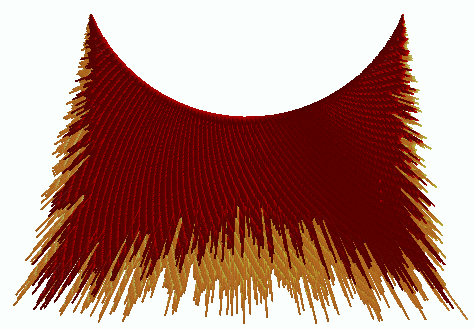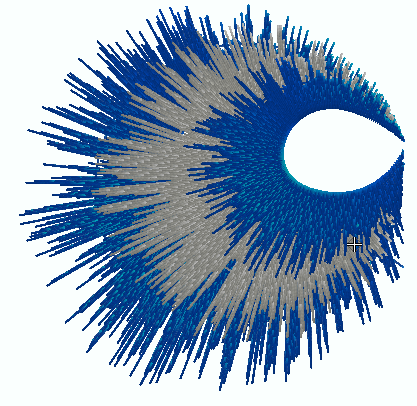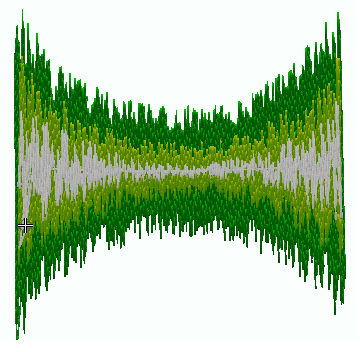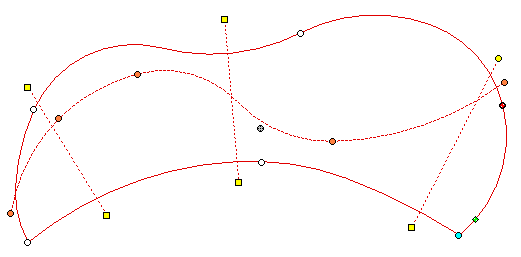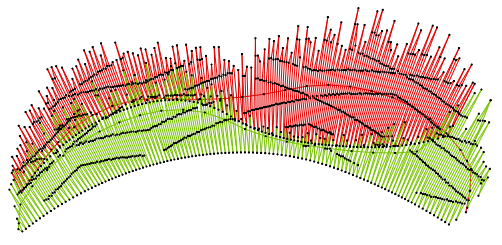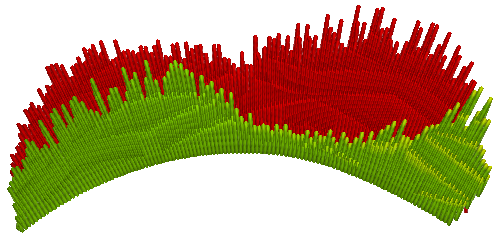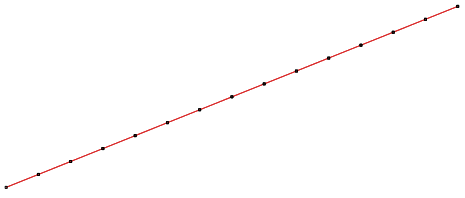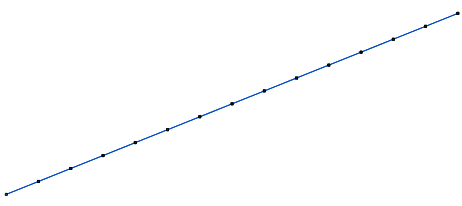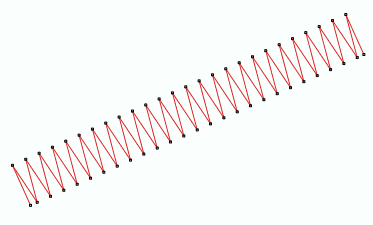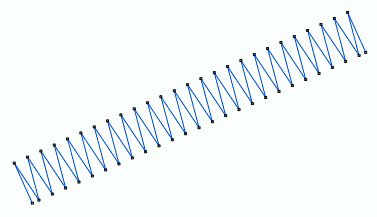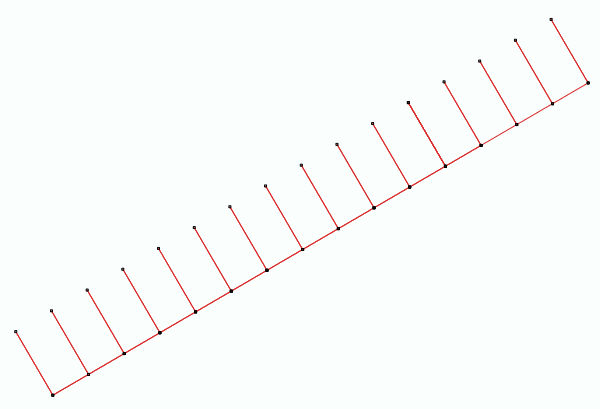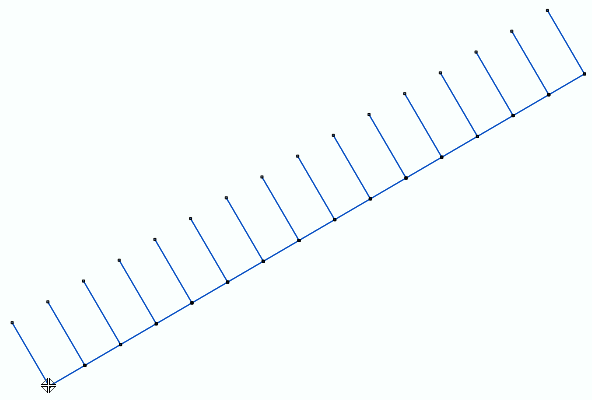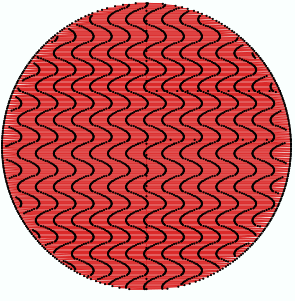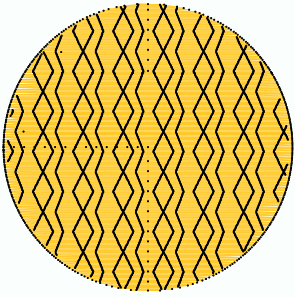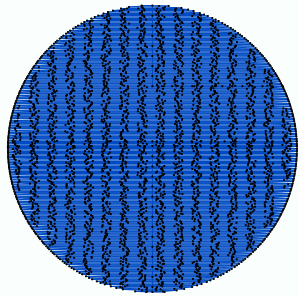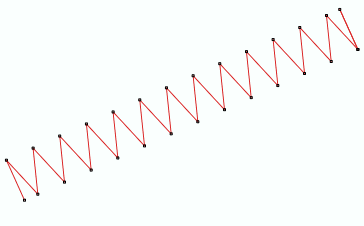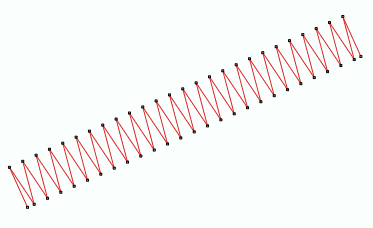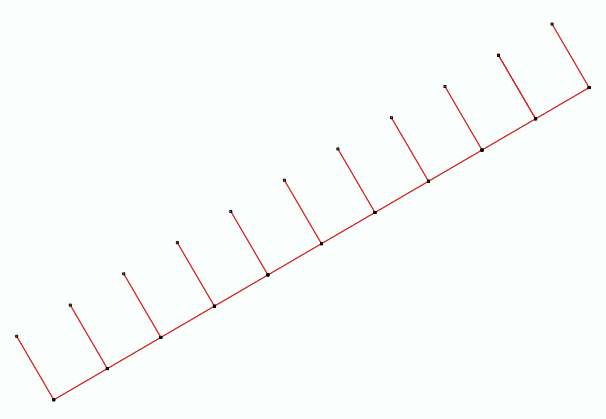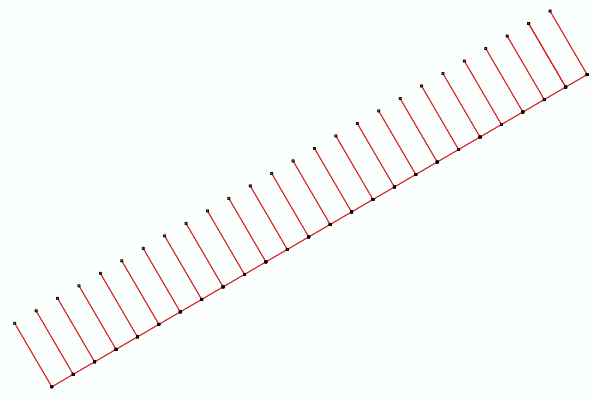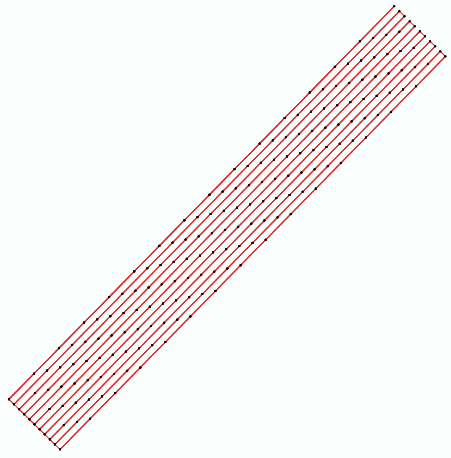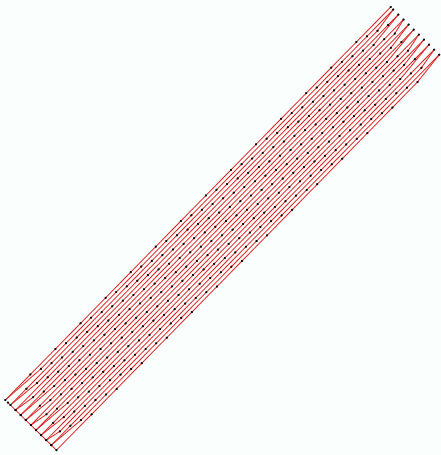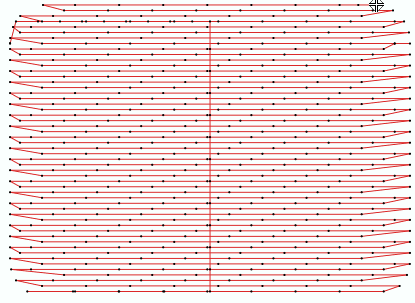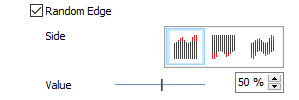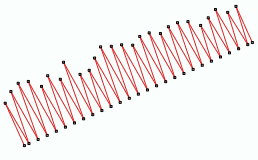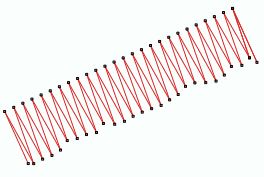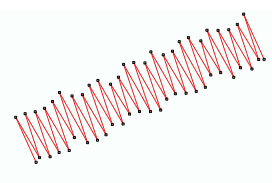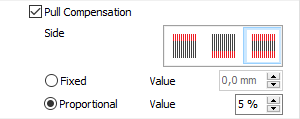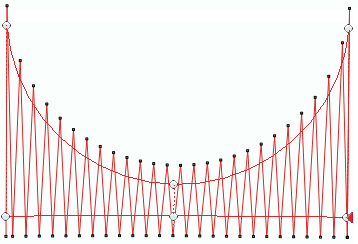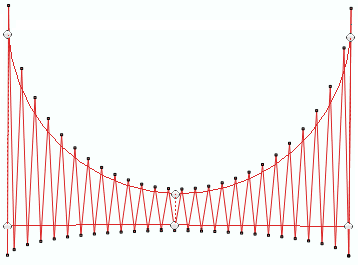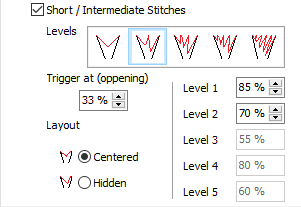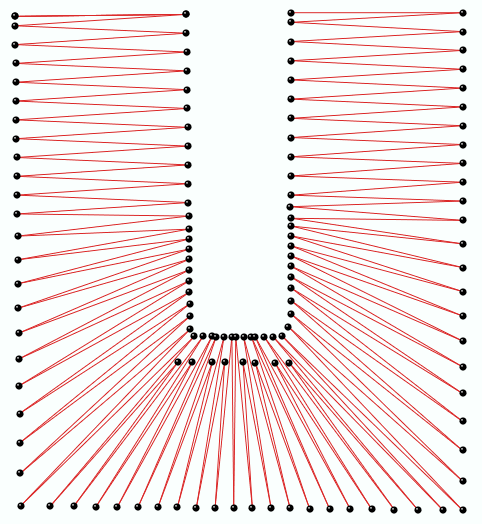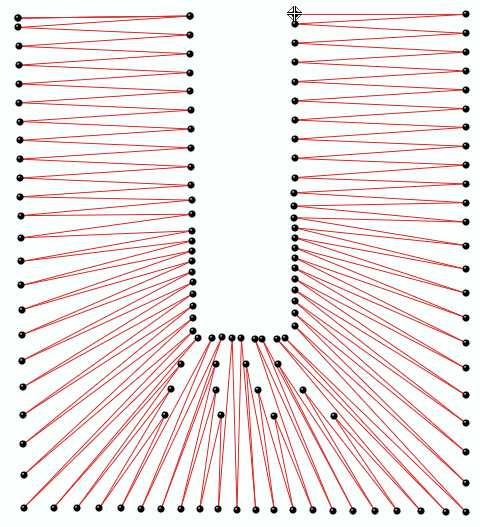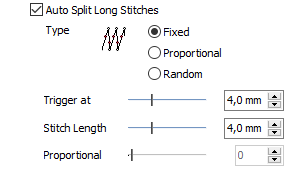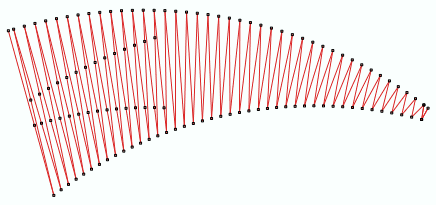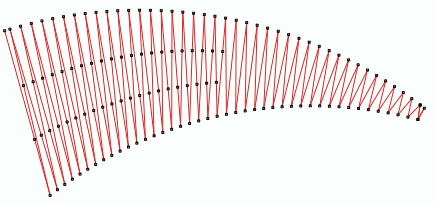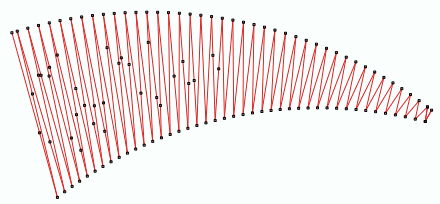
|
This fill style places one or several areas of pattern stitches with a random transformation effect on an area defined by a turning area object type. Stitches are oriented according to the defined direction lines.
|
How to create an object of this type?
➢Select the tool Create a Turning Area with Fur-Fill Pattern Stitches through any available way:
oOpen the Smart Design window and select the corresponding tool.
oClick on the arrow below the "Create Objects" button and select the corresponding tool.
oOpen the tooltab EMBROIDERY, click on the arrow below the "Turning Area" button and select the corresponding tool.
A context ToolsTab containing the most frequently used properties of this fill style will open.
➢Set the fill properties from the ToolsTab (above) or the Object Inspector (below).
➢Digitize the object (through any digitizing method) by inserting the required elements of this object type.
➢Confirm and GENERATE stitches.
➢If editing is required, just select the Select Object tool on the Main Toolbar. |
|

|
About Fill Style Properties
•You can edit (define or modify) all the properties of this object type from the Object Inspector (see below).
•The most commonly used properties are also available on the corresponding tooltab.
•The current value of the properties are displayed on the Object Inspector or the tooltab when an object of this type is being created or when an existing object of this type is selected. |
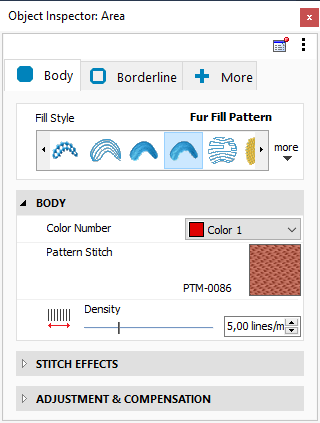
|
|

|
This is the color number of the thread/color palette.
|
|
You can change the color number from the color bar, from the context tooltab or from the object inspector.
The thread color for this color number is defined (and can be redefined) on the thread/color palette.
The stitches of the selected object will be created using the selected color.
This number is also the needle number of the embroidery machine (for multi-needle machines), unless the needle sequence is redefined.
|
Change Color Number on a Path with Running Stitches
Change Color Number on a Path with Zig-Zag Stitches
Change Color Number on a Path with E Stitches
|
It specifies the color number of the thread palette corresponding to the main color of the object.

|
It is the pattern component used to fill the area.
You can access the patterns library by clicking on the icon and select the one you want.
There are different categories of patterns:
•Math (uniform) patterns
•Creative (graphic) patterns
•Manual patterns
•Combined patterns. |
|
Math Pattern
|
|
Creative Pattern
|
|
|
|
|
|
Manual Pattern
|
|
Combined Pattern
|
|
|
|
|
|
It specifies the pattern component to use.

|
Set how many stitches or lines of stitches (by length unit) are created during the object creation.
The higher the density is, more stitches will created (and the spacing between them will decrease).
|
Stitch Density on a Path with Zig-Zag Stitches
|
Density: 3 stitches / mm
|
|
Density: 6 stitches / mm
|
|
|
|
|
Stitch Density on a Path with E Stitches
|
Density: 0.4 lines / mm
|
|
Density: 1.0 lines / mm
|
|
|
|
|
Stitch Density on a Path with Longitudinal Stitches
|
Density: 2 lines / mm
|
|
Density: 4 lines / mm
|
|
|
|
|
Stitch Density on an Area Path with Pattern Fill Stitches
|
Density: 2 lines / mm
|
|
Density: 6 lines / mm
|
|
|
|
|
|
It specifies the number of stitches or lines of stitches arrays of the object.
|

|
|
It turns irregular the edges of the object.
Properties:
•Side: Specify the object side where to apply the effect.
•Value: Adjust the width percentage affected by the effect.
|
Random Edge Side A
value: 40%
|
|
|
|
Random Edge Side B
value: 15%
|
|
|
|
Random Edge Both Sides
value: 25%
|
|
|
|
Add a random (irregular) effect on the border of the object.
|
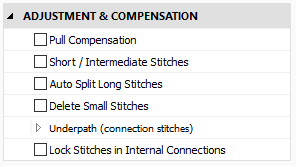
|
|
Correct the fabric shrink effect (caused by several factors, such as the stitch density, the type of fabric, the thread pull, etc) by by enlarging the stitches that tend to shrink when being embroidered. Basically, the stitches are stretched on their ends.
Properties are:
•Side: You can select the side (A, B, Both). Recommended value is Both.
•Type: Fixed or Proportional:
oFixed: You can set a fixed value, independent of the stitch length.
oProportional: This type varies according to the stitch length.
|
Fixed type, Value: 0.6 mm
|
|
Proportional Type, Value: 15%
|
|
|
|
|
|
Enlarge stitches to prevent shrink effect because of the thread tension.
Compensate the lack and the heaps of stitches when the stitch direction of Zig-Zag stitches changes noticeably (sharp curves). The program creates intermediate stitches in curves or tight corners to avoid an unnecessary amount up of stitches (in the smaller edge) and spaces (in the larger edge). Intermediate stitches are only created if the object requires it (trigger at threshold).
Properties are:
•Levels: The maximum number of intermediate stitches to create when required.
oLevel Value: Distance of the intermediate stitches, relative (percentage) to the stitch length.
•Layout options: centered or hidden
oCentered: intermediate stitches will be centered between the last and the next stitch.
oHidden: intermediate stitches will be orientated towards the next stitch.
•Trigger at: Set the minimum opening value (larger side / smaller site) to create intermediate stitches.
|
Levels: 1, Value: 85%, Trigger: 70%
|
|
Levels: 3, Value: 85%, Trigger: 70%
|
|
|
|
|
|
Add intermediate stitches in sharp curves to prevent an unnecessary amount up of stitches.
Split stitches in several parts on Zig-Zag stitches, when the stitch length exceeds the indicated value. It offers an approximation to the Zig-Zag style on objects that are wider than recommendad for Zig-Zag.
Auto Split types are:
oFixed: Stitches are split according to a fixed length. The defined value does not change along the stitches.
oProportional: Uses a percentage to split the stitches.
oRandom: Applies a random distribution on the split divisions.
Properties:
•Trigger at: Allows to set a value in which the split stitches will be applied.
•Stitch Length: It is the value (displayed in mm) that shows where the stitch splits.
•Proportional: It is the value (displayed in %) that shows where the stitch splits.
|
Fixed Split
|
|
|
|
Proportional Split
|
|
|
|
Random Split
|
|
|
|
It splits stitches when the stitch length exceeds the established value.
Filter the small stitches of the object (smaller than the indicated value).
Options are:
oAutomatic: The filter is enabled and the minimum stitch length used is the general value set in Options And Preferences.
oUser defined: The system will delete stitches shorter than the indicated value.
Sample of Delete Small Stitches: Path with Running Stitches
|
Before applying the filter
|
|
After applying the filter
|
|
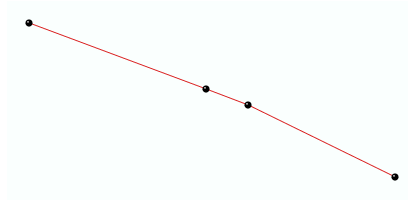
|
|
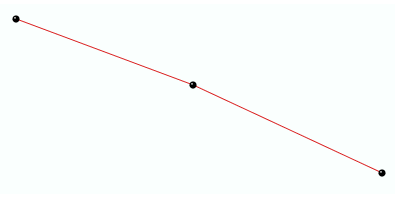
|
Sample of Delete Small Stitches: Column with Zig-Zag Stitches
|
Before applying the filter
|
|
After applying the filter
|
|
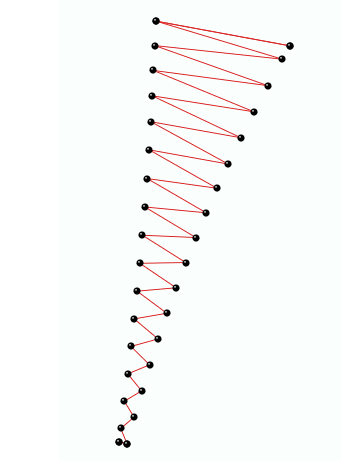
|
|
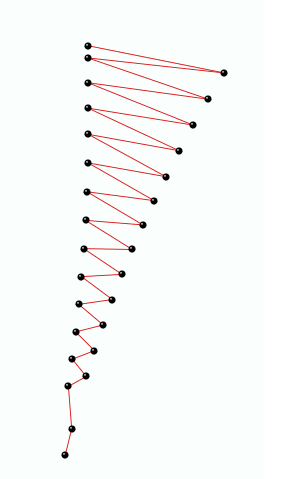
|
|
It deletes the stitches that are smaller than a predefined value (unnecessary & inconvenient).
Internal path or sequence of stitches automatically generated by the program required to travel from one location of the object to another one (connections of regions) while producing the stitches of the object in order to avoid long jumps. Those stitches will be hidden under the main fill.
Available options are:
oCenter Walk: The position of the under is set to the center (for normal density fills).
oEdge Walk: The position of the under is set at a certain distance from the edges (for low density fills).
Properties are:
•Stitch length: Defines the stitch length of the under path. The higher the value, the greater the stitches are apart from each other.
•Edge Distance: Defines the distance of under path to the edge.
|
Center Walk, Stitch Lenght: 1.0 mm
|
|
Edge Walk, Distance: 0.7 mm
|
|
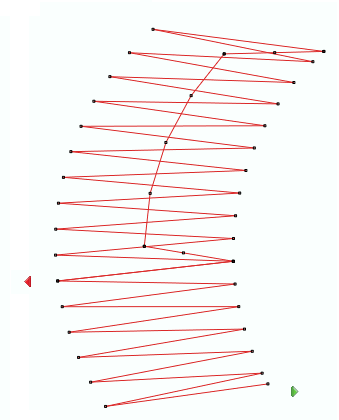
|
|
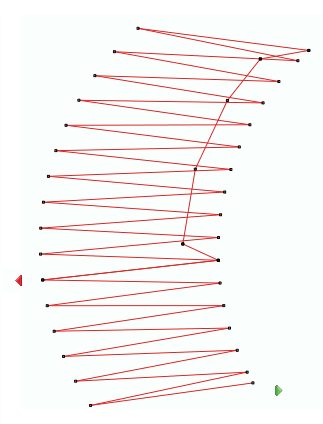
|
|
Not visible internal connections (paths) between different parts of a complex area.
Insert tack-down stitches to prevent unfixed stitches when connecting far parts of the object.
Types of Lock Stitches are:
oClassic
oStar
oTwist
oCross
oArrow
Properties:
•Length: Specify the lock stitch length for Classic type.
•Scale: change the size of the lock stitch.
•Repetition: Define the number of times to repeat the lock stitch.
|
It adds stitches to fix the thread, recommendable on thread trims and color changes.
|
Read also
•Concepts about the TURNING AREA object.
•Concepts about Classic Digitizing.
